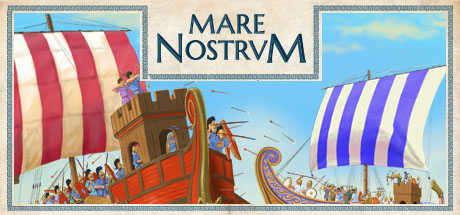Turnopia likes to think outside the box to offer us a game over a period and a type of war that is not very adapted, and in itself very little known.
On this point, we rediscover the ancient naval warfare with pleasure.
Developed by the small Spanish studio Turnopia, Mare Nostrvm intends to bring up to date the art of the ancient naval battles.
The Spanish Turnopia are behind the chariot racing simulator in Roman antiquity Qvadriga (2014), where you had to manage a team, its financing, its horses, its equipment, the experience of your runners, before to compete in dangerous races at the time of major competitions.
 You choose carefully how you do your turns, on which line you end up, if you need to give a little boost on your horses, or on your compe*****s to gain seats, while being careful that your stars of land do not die as a result of a (grand) racing accident. A little repetitive, the game was not the less friendly.After a remake in their own way of chess, in Chexs (2016), let's discover what Mare Nostrvm has to offer.
You choose carefully how you do your turns, on which line you end up, if you need to give a little boost on your horses, or on your compe*****s to gain seats, while being careful that your stars of land do not die as a result of a (grand) racing accident. A little repetitive, the game was not the less friendly.After a remake in their own way of chess, in Chexs (2016), let's discover what Mare Nostrvm has to offer.
NAVAL BATTLES IN ANTIQUITY?
For those who are unfamiliar with the ancient naval war, this is an opportunity for a short history lesson. The war in antiquity is not only a series of land fights between hoplitic phalanges and Roman legionaries, but also naval encounters between ships with several rows of rowers who rammed, bombarded each other with arrows, clung to each other to fight the embarked soldiers.

To give the importance of the military naval facts, let's remember that Salamis (-480) is a victory of the Greek triremes on the Persian ships during the Second Greco-Persian Wars, the battle of the Arginuses Islands (-406) makes the Spartan military power waver during the Peloponnesian War (431-404)against Athens, the Carthaginians violently opposed the Romans on the waters during the Punic wars (264-241 and 218-201 in particular), the brilliant naval campaign led by Cnaeus Pompeius Magnus in -67 against the scourge of the seas that were the pirates made his fame, and the battle of Actium (-31) makes triumph the future Princeps Caius Octavius.
SEAFARER' S SOBRIETY
Here we are again in an extremely sober game, both in its menus, texts, graphics, and in its sound effects mixing swell, drums and noise of features falling on your opponents' ships.
The action takes place during nine campaigns, ranging historically from Greek colonization in the eighth century BC to Roman civil wars culminating in the battle of Actium. You will therefore find all the above-mentioned battles, including the wars of the Diadokes, the successors of Alexander the Great, and the antiochic war (192-188) opposing Rome and Antiochos from the Seleucid dynasty.
To do this, it's simple: each campaign is a series of missions with a block of text summarizing the story and objectives, and you're immersed in the game. On the menu, you'll find your ships, those opposite, the wind that will speed up or slow down depending on the placement, and that's about it.
Your ships can be controlled individually, or in groups by selecting the ships where your strategists or admirals are located. The game is played in a simultaneous turn: you plan your moves, the goal of your moves if you meet an opponent, i. e. the ramming or the collision, and you launch the turn. The fleets advance, bombarded themselves with arrows within range, rammed themselves after complicated manoeuvres (cutting an enemy ship in half is always nice), and boarded.

The 14 types of ships, ranging from pirate lemboi, Roman Quinquereme, Greek triremes and Hellenistic massive ships up to ten ranks, have a variety of characteristics: cruising speed, the maximum speed you can impose on ships to the detriment of stability and fatigue of rowers, the quality of the ship, hull points, damage done by lorries, and so on. In skirmish mode, you can choose your ships more finely and equip the larger ones with artillery and combat towers.
Pro
+ The very little-known historical context
+ Great battles that involve finesse and dexterity
Con
- Extreme graphic and musical sobriety
